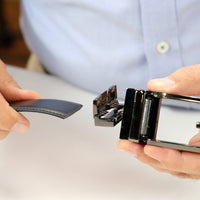Summary Points Leather belts for men offer durability, sophistication, and long-term value, making them ideal for formal and professional settings. Fabric belts for men provide flexibility, lig...
Continue ReadingNews
Custom Leather Belts How to Customize the Right Leather Belt for You
Summary Customizing your belt makes it fit your waist perfectly for comfort all day long. Picking full-grain leather gives you a strong belt that looks nicer over time. Adding personal stitching a...
Continue ReadingHow to Shorten a Leather Belt: A Step-by-Step Guide
Summary Measuring your waist accurately helps you shorten a leather belt for a perfect, comfortable fit. Removing the buckle carefully allows you to trim excess length without damaging the belt. C...
Continue ReadingHow to Custom Fit Your No-Hole Belt?
Summary: Measuring your waist accurately ensures a no-hole belt fits comfortably for any occasion daily. Trimming excess belt length carefully prevents over-cutting and keeps your belt looking nea...
Continue ReadingWhat's the Difference Between a Casual Belt and a Dress Belt?
Summary Dress belts feature slim, polished designs for formal looks, while casual belts are wider and textured for everyday wear. Dress belts feature glossy leather with minimalist buckles, contra...
Continue ReadingThe SureFit Belt Advantage: Comparing Traditional Belts to Modern Innovation
Summary Traditional belts haven’t changed in forever, but the SureFit Belt offers a smarter, more flexible design. Instead of fixed holes, it uses a micro-adjustable system that lets you get th...
Continue ReadingComfort Redefined: Exploring the Ergonomic Design of SureFit Belt
Summary The SureFit Belt prioritizes comfort with flexible, high-quality leather that adapts to your body, improving with each wear. A sliding buckle allows for micro-adjustments, ensuring a pe...
Continue ReadingLeather vs Fabric: Which Men’s Belt Material Should You Choose?
Summary Leather belts are more durable and long-lasting, making them a smart investment for regular or formal use. Fabric belts are lightweight, flexible, and perfect for casual or outdoor wear...
Continue ReadingThe Dos and Don'ts of Leather Belt Styling
Summary Coordinate your belt and shoes in the same color family to create a polished, intentional look. Slim belts work best for formal occasions, while wider belts suit casual outfits. Opt f...
Continue Reading























